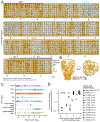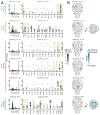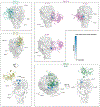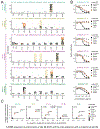Deep mutational scanning reveals functional constraints and antibody-escape potential of Lassa virus glycoprotein complex
- PMID: 39013466
- PMCID: PMC11390330
- DOI: 10.1016/j.immuni.2024.06.013
Deep mutational scanning reveals functional constraints and antibody-escape potential of Lassa virus glycoprotein complex
Abstract
Lassa virus is estimated to cause thousands of human deaths per year, primarily due to spillovers from its natural host, Mastomys rodents. Efforts to create vaccines and antibody therapeutics must account for the evolutionary variability of the Lassa virus's glycoprotein complex (GPC), which mediates viral entry into cells and is the target of neutralizing antibodies. To map the evolutionary space accessible to GPC, we used pseudovirus deep mutational scanning to measure how nearly all GPC amino-acid mutations affected cell entry and antibody neutralization. Our experiments defined functional constraints throughout GPC. We quantified how GPC mutations affected neutralization with a panel of monoclonal antibodies. All antibodies tested were escaped by mutations that existed among natural Lassa virus lineages. Overall, our work describes a biosafety-level-2 method to elucidate the mutational space accessible to GPC and shows how prospective characterization of antigenic variation could aid the design of therapeutics and vaccines.
Keywords: Arevirumab; Arevirumab-3; GPC; Lassa virus; antibody escape; antigenic variation; arena virus; deep mutational scanning; global epistasis.
Copyright © 2024 The Author(s). Published by Elsevier Inc. All rights reserved.
Conflict of interest statement
Declaration of interests J.D.B. is on the scientific advisory boards of Apriori Bio, Invivyd, Aerium Therapeutics, and the Vaccine Company. K.G.A. is a consultant to and on the scientific advisory board of Invivyd. J.D.B. and K.H.D.C. receive royalty payments as inventors on Fred Hutch licensed patents related to viral deep mutational scanning. N.P.K. is a co-founder, shareholder, paid consultant, and chair of the scientific advisory board of Icosavax, Inc. The King lab has received unrelated sponsored research agreements from Pfizer and GSK. M.M. is currently an employee of Seagen, though his contributions to this manuscript were performed when he was an employee of the Institute for Protein Design.
Figures







Update of
-
Deep mutational scanning reveals functional constraints and antigenic variability of Lassa virus glycoprotein complex.bioRxiv [Preprint]. 2024 Feb 6:2024.02.05.579020. doi: 10.1101/2024.02.05.579020. bioRxiv. 2024. Update in: Immunity. 2024 Sep 10;57(9):2061-2076.e11. doi: 10.1016/j.immuni.2024.06.013. PMID: 38370709 Free PMC article. Updated. Preprint.
References
Publication types
MeSH terms
Substances
Grants and funding
LinkOut - more resources
Full Text Sources

